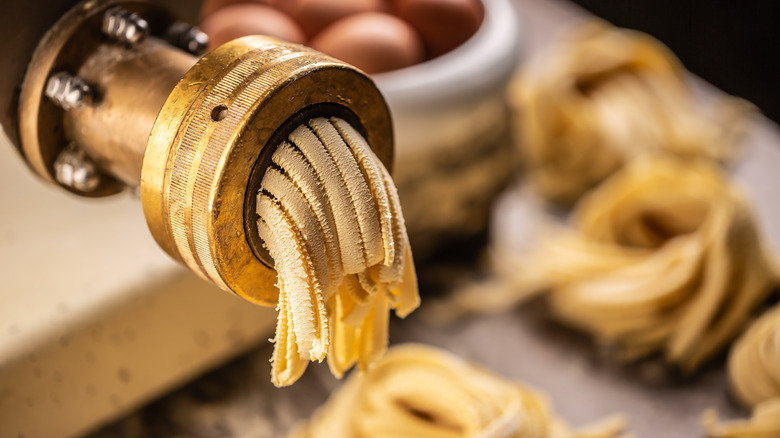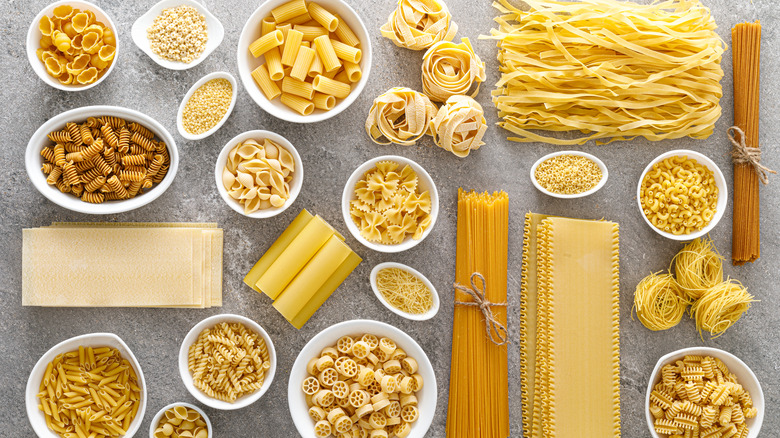Lidia Bastianich's Tip For Picking The Best Dried Pasta
Dried pasta is a relatively inexpensive product that can feed a crowd. Boxes of pasta can stay in your pantry for quite some time, making meal prep a cinch. According to Italy Magazine, there are over 350 different types of pasta, with a shape to accompany every sauce.
Pasta can be categorized into short, long, stuffed, and soup pasta. Each type of pasta can be prepared using various ingredients (most notably with or without gluten) and are available in both dried and fresh forms. Short pasta versions include penne, fusilli, and rigatoni. Long pastas include fettuccine, tagliatelle, and bucatini. Ravioli, manicotti, and tortellini (the latter of which was, according to legend, invented by a peeping Tom who snuck a look at the goddess Venus' navel) are types of stuffed pasta. Soup pasta may seem like an unusual category, but these small-shaped pasta varieties are created to be eaten with a spoon. These pasta shapes are often served to children and include pastina (tiny star-shaped) and anellini (those little rings in cans of Chef Boyardee).
Traditionally, pasta is named after the object found in nature that it resembles. For example, the small cup-shaped orecchiette means "little ear," and the bowtie-looking farfalle means butterflies. In Italian, the suffix 'ini' is added to a basic pasta shape, like spaghetti, to indicate a smaller version (spaghettini) or the suffix 'oni,' for pasta that is larger (spaghettoni). Chef Lidia Bastianich has suggestions for picking the right pasta to make Sunday's family supper even tastier.
What to look for when buying pasta
In a People magazine article, Bastianich shares her tips on purchasing dried pasta. Although some of the suggestions seem obvious, like avoiding boxes that have dust on them or broken pasta since it can reflect how old the pasta is, other tips are more subtle and arguably more important.
Bastianich advises home cooks to buy pasta with a golden yellow hue and a rough texture. The color indicates the pasta is made from 100% durum wheat semolina flour which has a higher gluten content than all-purpose. Unlike the bleached white varieties found for under a buck, pasta made with semolina flour can hold its shape when twisted (fusilli) or pressed (orecchiette) and won't fall apart while cooking. Since semolina flour is milled coarser, it has a pleasant mouthfeel and texture (via Bob's Red Mill).
The commercial mold that manufacturers use to shape the pasta also contributes to the rough texture. Traditionally a bronze die was used, giving the pasta a rugged, porous surface, ideal for the sauce to cling to. A less expensive, modern way to form the pasta is with a Teflon die. Like your egg pan, nothing sticks to a Teflon die, leaving a smooth surface on the pasta, allowing the sauce to slide off. Expect to pay a few dollars more for bronze-cut pasta, but it's undoubtedly worth it after your hard work on the sauce.
Eat pasta like an Italian
In Italy, pasta is the star of the plate, and sauce is a condiment to be used modestly. Perhaps chef Sara Jenkins of New York City's Porchetta put it best when she said, "After you've eaten the pasta, there should be just enough sauce left in the bowl to swipe a small piece of crusty bread through" (great visual). To cook like an Italian chef, match the shape of the pasta to the sauce. Pasta Evangelists has a guide for picking the best sauce to go with the right style of pasta.
Long, thin pasta like spaghetti is meant to be coated in a delicate cream or oil-based sauce like pesto (please don't use a spoon to twirl or a knife to cut your spaghetti). Long, flat ribbons of pasta like tagliatelle are best suited for hearty sauces like Anne Burrell's bolognese. Short, tubed pasta like rigatoni is ideal for the likes of vodka sauce to coat and cling to it. Finally, when serving a stuffed pasta like ravioli, choose a simple sauce like browned butter and sage to allow the pasta filling to shine.
With eight locations in the US and eighteen more abroad, Bastianich's Eataly is a playground for Italian-loving foodies. This one-stop shop is well-curated, highlighting how Italians eat. Along with Bastianich's brand, shoppers can find all shapes of bronze-cut pasta, fresh and dried for their next meal (and enjoy a glass of wine while doing it). Buon appetito!


